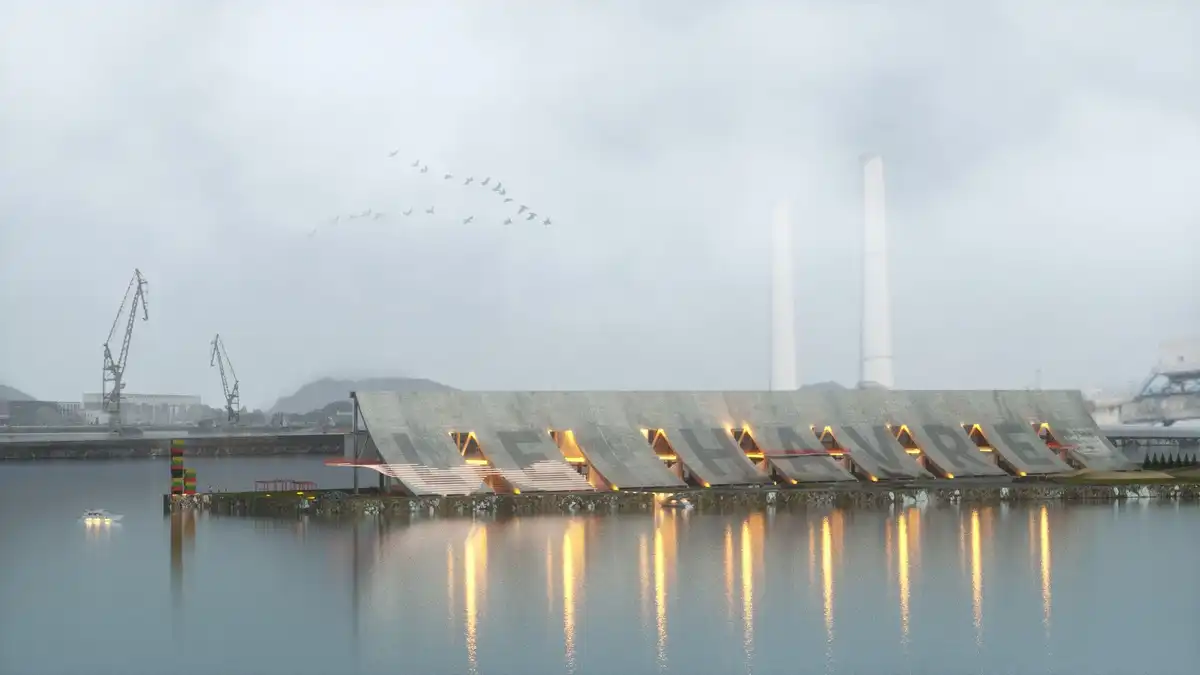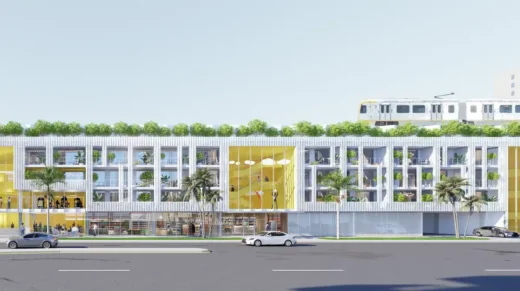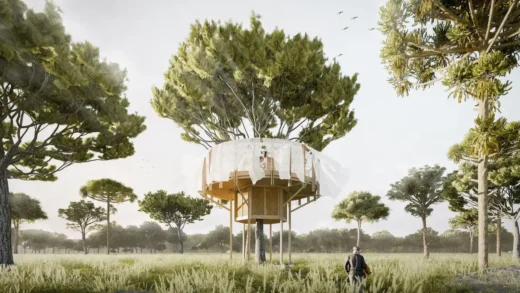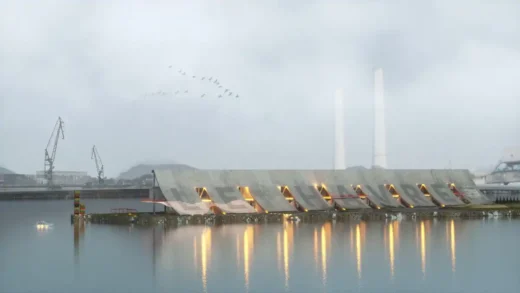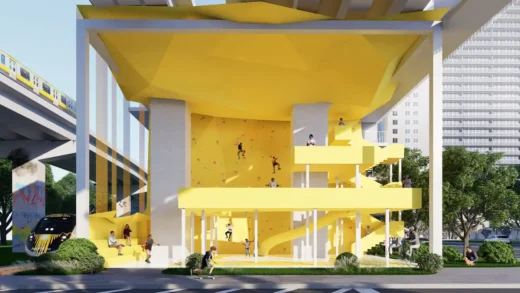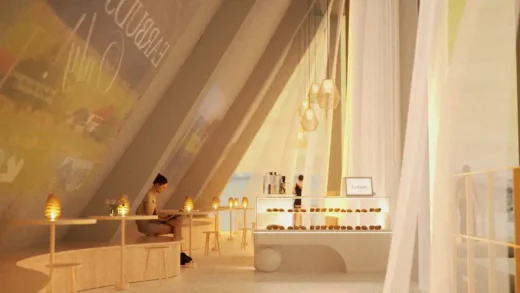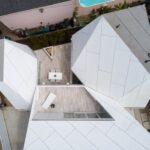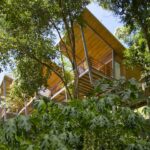Yuejun Han on Form and Context: architecture design style
Beginning with the Given: Yuejun Han on Form and Context
April 30, 2025
For Yuejun Han, architecture begins with what already exists. Whether it’s a bridge, a tree, or a forgotten windbreak wall, her design approach treats context as instruction – not as resistance to be overcome, but as a structure to be extended. She believes that design is not a matter of imposing clarity, but of refining it – making visible the spatial rhythms that are already in play. This philosophy shapes how she works across projects and scales, from infrastructural reuse to quiet domestic space.
Her work offers a clear public benefit – especially in urban contexts like the United States, where spatial fragmentation, housing shortages, and aging infrastructure remain pressing challenges Rather than pursue spectacle or impose newness, she focuses on repairing and extending what already exists. Her projects reframe infrastructural leftovers and typological limits as opportunities for civic usefulness and social continuity. This sensibility is especially relevant in contexts where architecture is asked not only to innovate, but to restore – to do more with what has already been built.
In this interview, Han reflects on how this philosophy plays out in practice-across bridges, forests, and disused military infrastructure – and how architectural form can operate less as a statement than as a listening device.
Q: What kind of role do you think form should play – and how do you approach it in your own work?
A: I don’t see form as a signature or a gesture. It starts with listening – to the site, the structure, the existing rhythm. I try to begin with the given. That might be an infrastructural span, a tree’s geometry, or a cultural trace. I look for latent logic: scale, light, rhythm, friction. Form, for me, is a way of responding to what’s already there. Sometimes that means extending the existing form, sometimes creating contrast, or drawing a new boundary. The goal isn’t to impose order, but to clarify what the site already holds – and to give that clarity room to resonate.
That’s usually where the process begins. I don’t start with an idea and look for a place to apply it. I begin with the context and try to read what it’s already doing. The form follows from that reading – whether it’s reinforcing something, reversing it, or letting it remain undefined. It’s not about control. It’s about attentiveness.
Q: Could you give an example of how you begin with the given in your work?
A: It happens in different ways, depending on the scale, the material, or the nature of the site. In Re-Bridge, we didn’t see the underside of a bridge as a void to fill, but as a framework already rich with structure. The site gave us rhythm, shade, and continuity – we simply interpreted it. The housing modules were suspended independently, following the span’s logic while carving out walkable ground-level spaces that reconnected the city’s fragmented pedestrian networks. It wasn’t about inserting new architecture, but restoring flow where it had been broken.
In Behind the Curtain, the given wasn’t a structure – it was a pine tree. But it offered a clear spatial logic: canopy, trunk, roots. The architecture followed that organization. We used soft materials – primarily curtains – not to erase boundaries, but to make transitions more permeable between interior and exterior, between activity and stillness. It wasn’t a house with rooms, but a layered environment that responded to daily rituals, shifting seasons, and subtle changes in light and privacy. Its flexibility wasn’t a concept; it came from the specific qualities of the site and the meditative rhythm of its inhabitants.
Re-Landing was a different scale, but the principle was the same. The 240-meter concrete arc of the Brise-Vent wasn’t erased or even altered. We treated it as an active framework. We added theater-style seating on top, skate parks that extend its curve into the landscape, and viewing platforms that project from its structural gaps. These additions remain structurally independent, so the original form stays intact. The result isn’t contrast – it’s dialogue. The old gives rhythm, the new gives use. In all three cases, architecture wasn’t about invention. It was about alignment.
Q: You’ve also worked on major infrastructure and transit projects in professional practice. How has that experience influenced your thinking?
A: Working on large-scale infrastructure taught me to see spatial systems not in isolation, but as networks. You realize quickly that even small design moves have to negotiate with larger logics – circulation, access, maintenance, even politics. That experience trained me to locate where a subtle spatial decision can make a disproportionate impact. It also deepened my respect for the given – not just as physical context, but as institutional and urban structure.
In professional practice, I’ve brought this same mindset to large-scale mix-use and transportation projects. In those contexts, architectural form often mediates between logistical systems and lived experience – shaping how people arrive, orient, and participate in public space. That also includes material decisions, like whether to reference local geologies through horizontal striation, or to use regionally available stone for both cost and cultural continuity. These choices aren’t symbolic; they try to respond thoughtfully to where the project is and who it’s for.
Q: Do you believe architectural form can influence social structure?
A: Yes, though not always in obvious ways. Form can invite or exclude, guide or obscure. It defines thresholds – where people pause, enter, gather, or retreat. Even the decision to preserve an existing condition or leave something undefined has social consequences. In Re-Bridge, the repositioning of circulation and housing under the bridge reorganized not just space, but how people meet and move. In Re-Landing, the insertion of viewing decks and skateable surfaces turned a war memorial into a site of shared, everyday life. I think architecture’s role is to clarify without controlling, to shape space that encourages participation rather than obedience.
Q: Your work moves across scales and programs – from housing systems to meditative retreats. What kinds of spaces do you want to design more of?
A: I’m drawn to contexts that already have tension in them, whether structural or social. Not because they’re messy, but because they already hold energy. Whether I’m working with a leftover void in the city or a tree in the forest, I begin with what already holds the space together. Some projects ask for more lightness, some for more structure – but the approach stays the same: to begin with the given, and respond. I want to design spaces that are precise but not prescriptive, that can shift as people use them differently. Architecture doesn’t need to answer everything. Sometimes it just needs to set the stage.
———————————–
About the Designer
Yuejun Han is an architectural designer based in Los Angeles. Her work spans transportation, infrastructure, mixed-use developments, housing, transit hubs, and research-based design, with a focus on typology, reuse, and the ethics of spatial decision-making. Her work has been recognized by ArchDaily, Archinect, Bustler, the MUSE Design Awards, and Arch Design Award.
Linkedin: https://www.linkedin.com/in/yuejun-han/
Comments on this guide to Yuejun Han on Form and Context: architecture design article are welcome.
American Architecture Designs
American Architectural Designs – recent selection from e-architect:
House Design
Residential Architecture
Comments / photos for the Yuejun Han on Form and Context: architecture design page welcome.

